Analysis of High-Intensity Interval Training in Cardiac Patients
VerifiedAdded on 2020/01/07
|14
|3943
|175
Report
AI Summary
This report delves into the value of high-intensity interval training (HIIT) for cardiac patients, exploring its effectiveness and impact on heart health. The report analyzes research findings from various studies, including those by Gibala et al. (2012), Hoeger and Hoeger (2016), and Wang et al. The a...
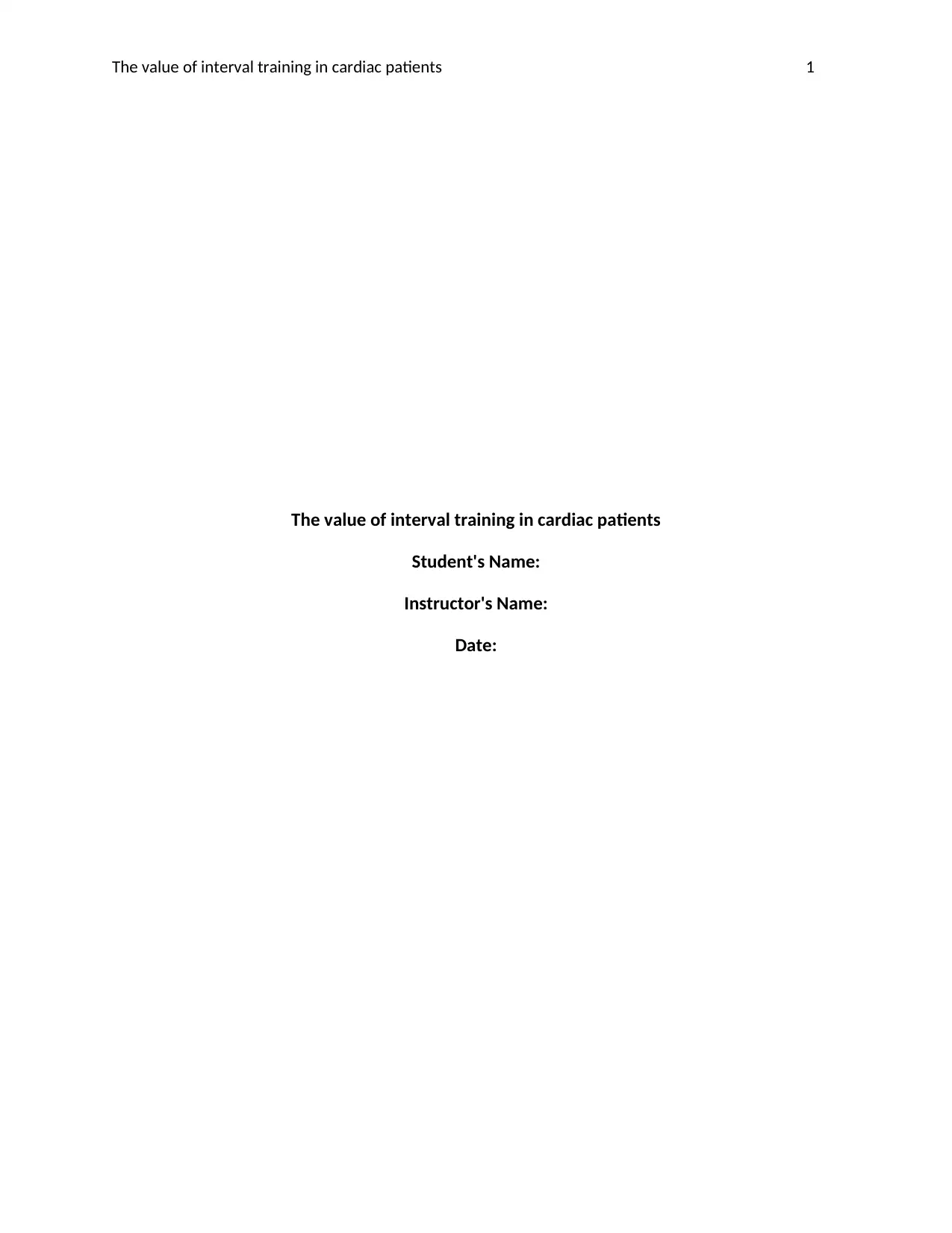
The value of interval training in cardiac patients 1
The value of interval training in cardiac patients
Student's Name:
Instructor's Name:
Date:
The value of interval training in cardiac patients
Student's Name:
Instructor's Name:
Date:
Paraphrase This Document
Need a fresh take? Get an instant paraphrase of this document with our AI Paraphraser
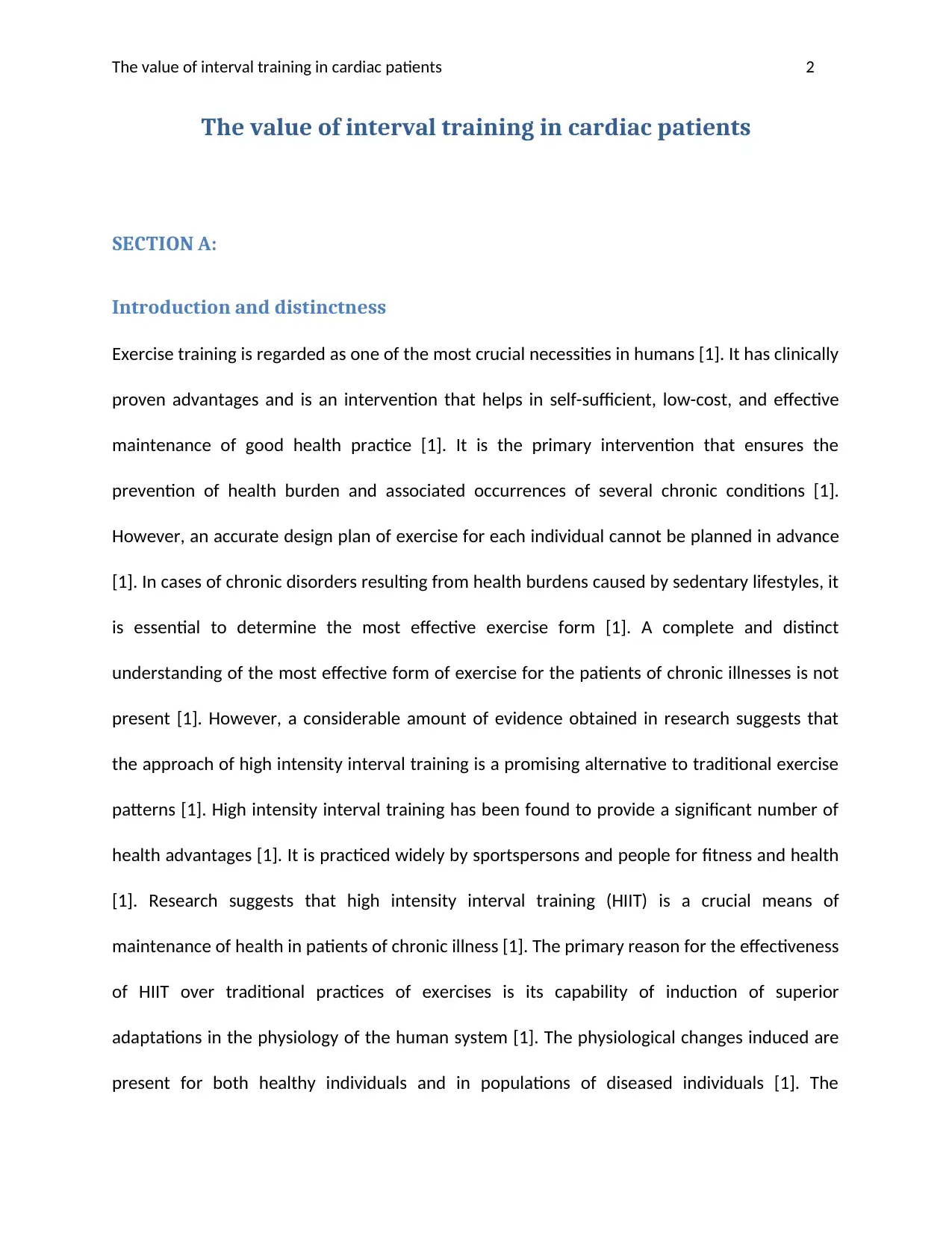
The value of interval training in cardiac patients 2
The value of interval training in cardiac patients
SECTION A:
Introduction and distinctness
Exercise training is regarded as one of the most crucial necessities in humans [1]. It has clinically
proven advantages and is an intervention that helps in self-sufficient, low-cost, and effective
maintenance of good health practice [1]. It is the primary intervention that ensures the
prevention of health burden and associated occurrences of several chronic conditions [1].
However, an accurate design plan of exercise for each individual cannot be planned in advance
[1]. In cases of chronic disorders resulting from health burdens caused by sedentary lifestyles, it
is essential to determine the most effective exercise form [1]. A complete and distinct
understanding of the most effective form of exercise for the patients of chronic illnesses is not
present [1]. However, a considerable amount of evidence obtained in research suggests that
the approach of high intensity interval training is a promising alternative to traditional exercise
patterns [1]. High intensity interval training has been found to provide a significant number of
health advantages [1]. It is practiced widely by sportspersons and people for fitness and health
[1]. Research suggests that high intensity interval training (HIIT) is a crucial means of
maintenance of health in patients of chronic illness [1]. The primary reason for the effectiveness
of HIIT over traditional practices of exercises is its capability of induction of superior
adaptations in the physiology of the human system [1]. The physiological changes induced are
present for both healthy individuals and in populations of diseased individuals [1]. The
The value of interval training in cardiac patients
SECTION A:
Introduction and distinctness
Exercise training is regarded as one of the most crucial necessities in humans [1]. It has clinically
proven advantages and is an intervention that helps in self-sufficient, low-cost, and effective
maintenance of good health practice [1]. It is the primary intervention that ensures the
prevention of health burden and associated occurrences of several chronic conditions [1].
However, an accurate design plan of exercise for each individual cannot be planned in advance
[1]. In cases of chronic disorders resulting from health burdens caused by sedentary lifestyles, it
is essential to determine the most effective exercise form [1]. A complete and distinct
understanding of the most effective form of exercise for the patients of chronic illnesses is not
present [1]. However, a considerable amount of evidence obtained in research suggests that
the approach of high intensity interval training is a promising alternative to traditional exercise
patterns [1]. High intensity interval training has been found to provide a significant number of
health advantages [1]. It is practiced widely by sportspersons and people for fitness and health
[1]. Research suggests that high intensity interval training (HIIT) is a crucial means of
maintenance of health in patients of chronic illness [1]. The primary reason for the effectiveness
of HIIT over traditional practices of exercises is its capability of induction of superior
adaptations in the physiology of the human system [1]. The physiological changes induced are
present for both healthy individuals and in populations of diseased individuals [1]. The
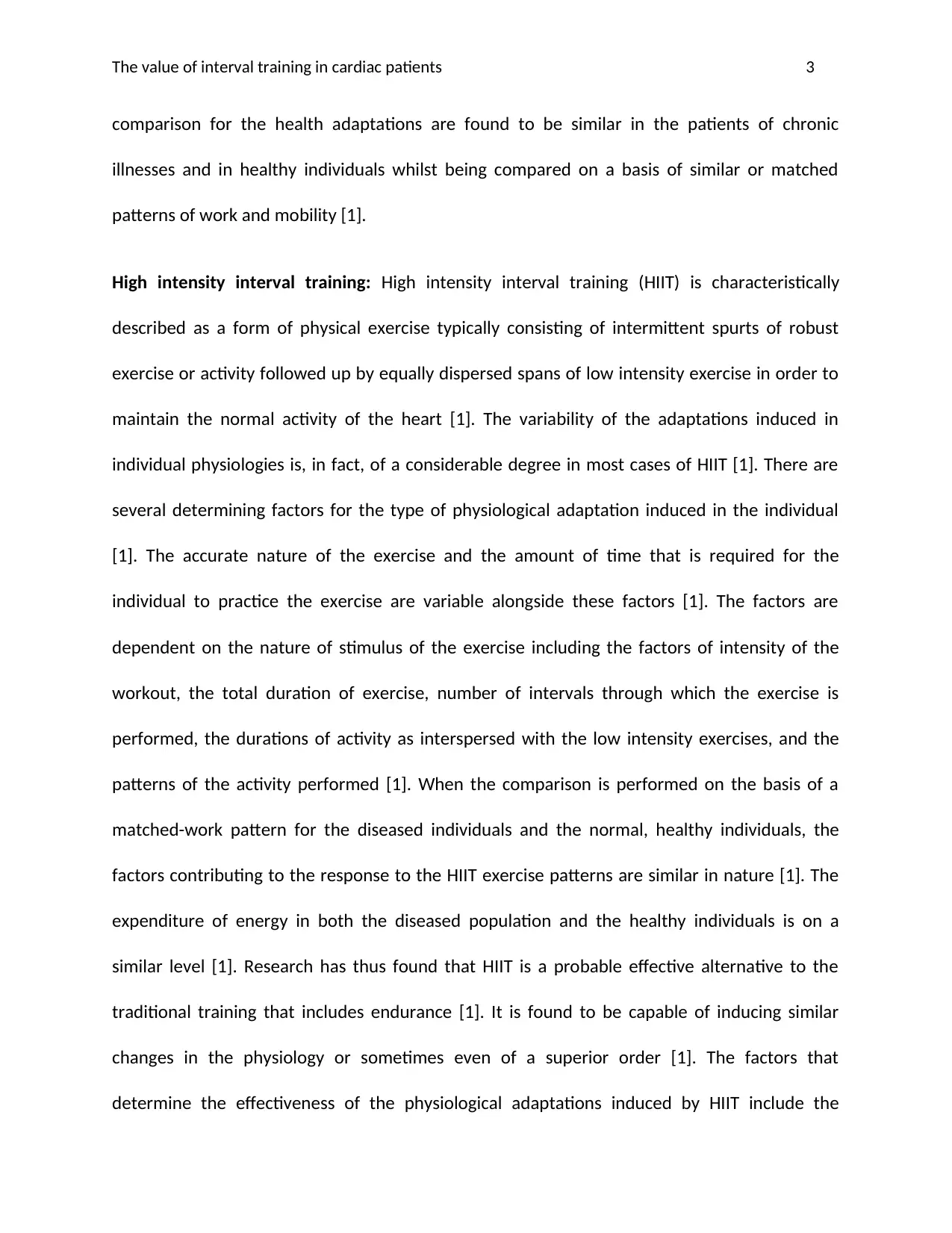
The value of interval training in cardiac patients 3
comparison for the health adaptations are found to be similar in the patients of chronic
illnesses and in healthy individuals whilst being compared on a basis of similar or matched
patterns of work and mobility [1].
High intensity interval training: High intensity interval training (HIIT) is characteristically
described as a form of physical exercise typically consisting of intermittent spurts of robust
exercise or activity followed up by equally dispersed spans of low intensity exercise in order to
maintain the normal activity of the heart [1]. The variability of the adaptations induced in
individual physiologies is, in fact, of a considerable degree in most cases of HIIT [1]. There are
several determining factors for the type of physiological adaptation induced in the individual
[1]. The accurate nature of the exercise and the amount of time that is required for the
individual to practice the exercise are variable alongside these factors [1]. The factors are
dependent on the nature of stimulus of the exercise including the factors of intensity of the
workout, the total duration of exercise, number of intervals through which the exercise is
performed, the durations of activity as interspersed with the low intensity exercises, and the
patterns of the activity performed [1]. When the comparison is performed on the basis of a
matched-work pattern for the diseased individuals and the normal, healthy individuals, the
factors contributing to the response to the HIIT exercise patterns are similar in nature [1]. The
expenditure of energy in both the diseased population and the healthy individuals is on a
similar level [1]. Research has thus found that HIIT is a probable effective alternative to the
traditional training that includes endurance [1]. It is found to be capable of inducing similar
changes in the physiology or sometimes even of a superior order [1]. The factors that
determine the effectiveness of the physiological adaptations induced by HIIT include the
comparison for the health adaptations are found to be similar in the patients of chronic
illnesses and in healthy individuals whilst being compared on a basis of similar or matched
patterns of work and mobility [1].
High intensity interval training: High intensity interval training (HIIT) is characteristically
described as a form of physical exercise typically consisting of intermittent spurts of robust
exercise or activity followed up by equally dispersed spans of low intensity exercise in order to
maintain the normal activity of the heart [1]. The variability of the adaptations induced in
individual physiologies is, in fact, of a considerable degree in most cases of HIIT [1]. There are
several determining factors for the type of physiological adaptation induced in the individual
[1]. The accurate nature of the exercise and the amount of time that is required for the
individual to practice the exercise are variable alongside these factors [1]. The factors are
dependent on the nature of stimulus of the exercise including the factors of intensity of the
workout, the total duration of exercise, number of intervals through which the exercise is
performed, the durations of activity as interspersed with the low intensity exercises, and the
patterns of the activity performed [1]. When the comparison is performed on the basis of a
matched-work pattern for the diseased individuals and the normal, healthy individuals, the
factors contributing to the response to the HIIT exercise patterns are similar in nature [1]. The
expenditure of energy in both the diseased population and the healthy individuals is on a
similar level [1]. Research has thus found that HIIT is a probable effective alternative to the
traditional training that includes endurance [1]. It is found to be capable of inducing similar
changes in the physiology or sometimes even of a superior order [1]. The factors that
determine the effectiveness of the physiological adaptations induced by HIIT include the
You're viewing a preview
Unlock full access by subscribing today!
Enjoy unlimited downloads | Full document access |
Advanced AI study tools
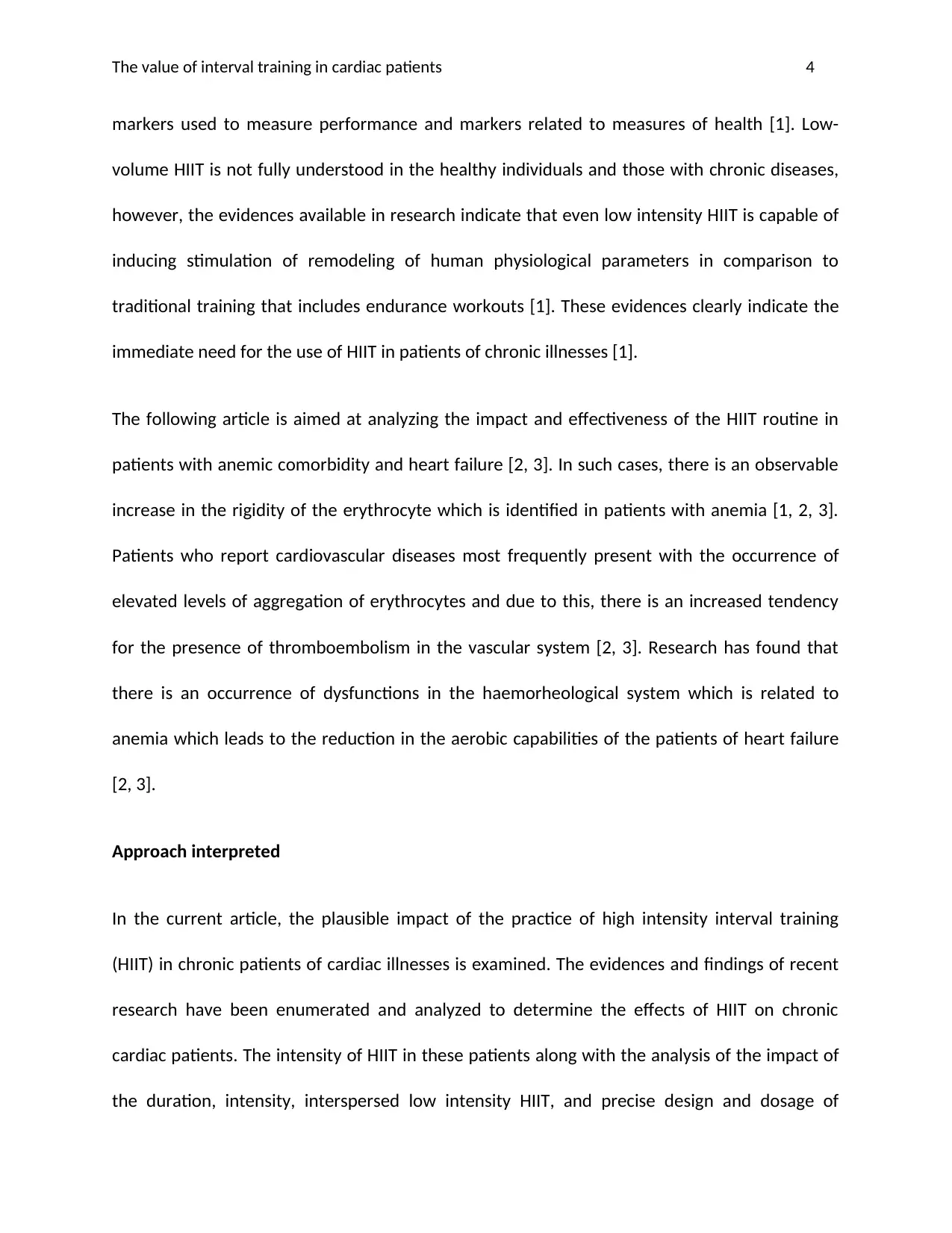
The value of interval training in cardiac patients 4
markers used to measure performance and markers related to measures of health [1]. Low-
volume HIIT is not fully understood in the healthy individuals and those with chronic diseases,
however, the evidences available in research indicate that even low intensity HIIT is capable of
inducing stimulation of remodeling of human physiological parameters in comparison to
traditional training that includes endurance workouts [1]. These evidences clearly indicate the
immediate need for the use of HIIT in patients of chronic illnesses [1].
The following article is aimed at analyzing the impact and effectiveness of the HIIT routine in
patients with anemic comorbidity and heart failure [2, 3]. In such cases, there is an observable
increase in the rigidity of the erythrocyte which is identified in patients with anemia [1, 2, 3].
Patients who report cardiovascular diseases most frequently present with the occurrence of
elevated levels of aggregation of erythrocytes and due to this, there is an increased tendency
for the presence of thromboembolism in the vascular system [2, 3]. Research has found that
there is an occurrence of dysfunctions in the haemorheological system which is related to
anemia which leads to the reduction in the aerobic capabilities of the patients of heart failure
[2, 3].
Approach interpreted
In the current article, the plausible impact of the practice of high intensity interval training
(HIIT) in chronic patients of cardiac illnesses is examined. The evidences and findings of recent
research have been enumerated and analyzed to determine the effects of HIIT on chronic
cardiac patients. The intensity of HIIT in these patients along with the analysis of the impact of
the duration, intensity, interspersed low intensity HIIT, and precise design and dosage of
markers used to measure performance and markers related to measures of health [1]. Low-
volume HIIT is not fully understood in the healthy individuals and those with chronic diseases,
however, the evidences available in research indicate that even low intensity HIIT is capable of
inducing stimulation of remodeling of human physiological parameters in comparison to
traditional training that includes endurance workouts [1]. These evidences clearly indicate the
immediate need for the use of HIIT in patients of chronic illnesses [1].
The following article is aimed at analyzing the impact and effectiveness of the HIIT routine in
patients with anemic comorbidity and heart failure [2, 3]. In such cases, there is an observable
increase in the rigidity of the erythrocyte which is identified in patients with anemia [1, 2, 3].
Patients who report cardiovascular diseases most frequently present with the occurrence of
elevated levels of aggregation of erythrocytes and due to this, there is an increased tendency
for the presence of thromboembolism in the vascular system [2, 3]. Research has found that
there is an occurrence of dysfunctions in the haemorheological system which is related to
anemia which leads to the reduction in the aerobic capabilities of the patients of heart failure
[2, 3].
Approach interpreted
In the current article, the plausible impact of the practice of high intensity interval training
(HIIT) in chronic patients of cardiac illnesses is examined. The evidences and findings of recent
research have been enumerated and analyzed to determine the effects of HIIT on chronic
cardiac patients. The intensity of HIIT in these patients along with the analysis of the impact of
the duration, intensity, interspersed low intensity HIIT, and precise design and dosage of
Paraphrase This Document
Need a fresh take? Get an instant paraphrase of this document with our AI Paraphraser
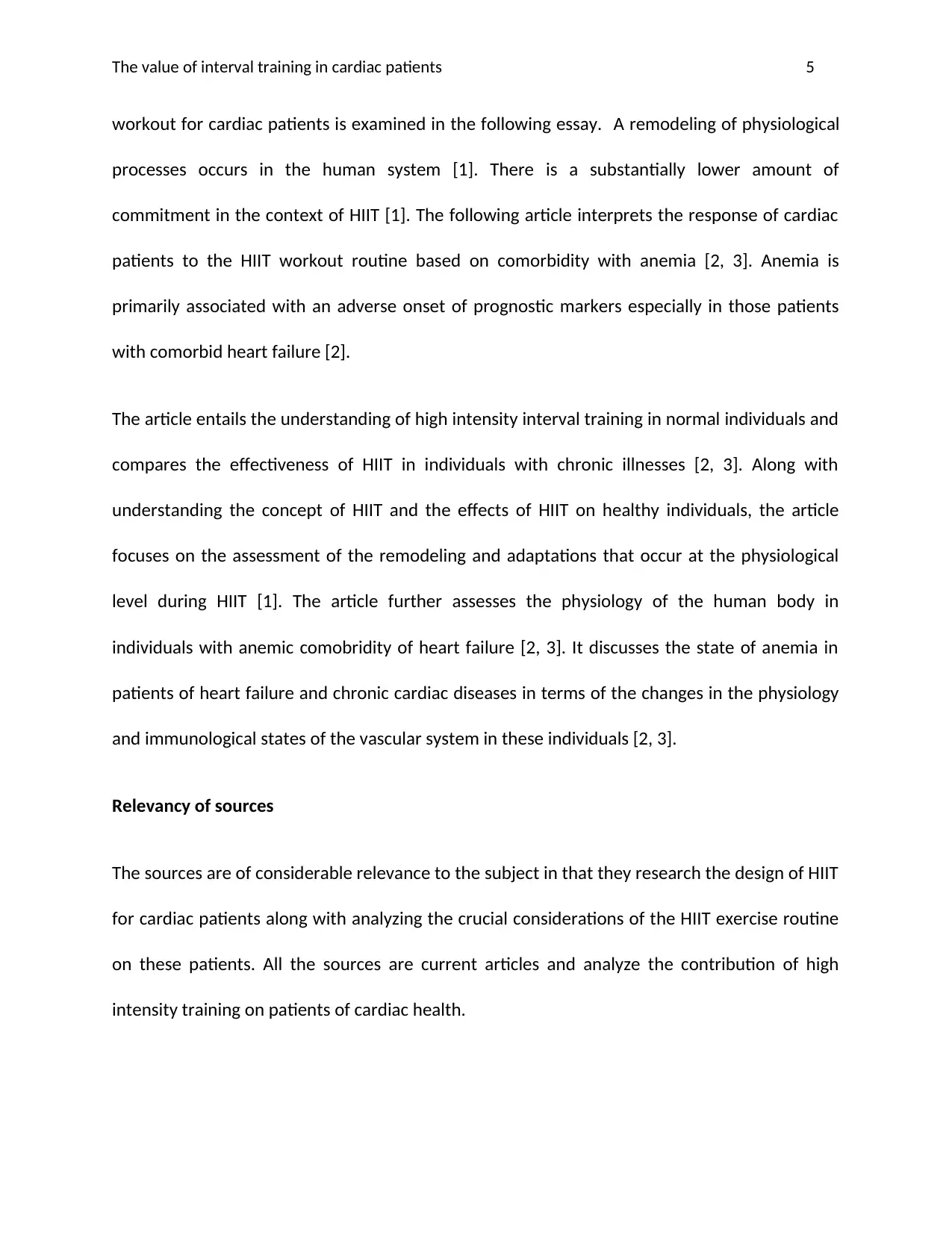
The value of interval training in cardiac patients 5
workout for cardiac patients is examined in the following essay. A remodeling of physiological
processes occurs in the human system [1]. There is a substantially lower amount of
commitment in the context of HIIT [1]. The following article interprets the response of cardiac
patients to the HIIT workout routine based on comorbidity with anemia [2, 3]. Anemia is
primarily associated with an adverse onset of prognostic markers especially in those patients
with comorbid heart failure [2].
The article entails the understanding of high intensity interval training in normal individuals and
compares the effectiveness of HIIT in individuals with chronic illnesses [2, 3]. Along with
understanding the concept of HIIT and the effects of HIIT on healthy individuals, the article
focuses on the assessment of the remodeling and adaptations that occur at the physiological
level during HIIT [1]. The article further assesses the physiology of the human body in
individuals with anemic comobridity of heart failure [2, 3]. It discusses the state of anemia in
patients of heart failure and chronic cardiac diseases in terms of the changes in the physiology
and immunological states of the vascular system in these individuals [2, 3].
Relevancy of sources
The sources are of considerable relevance to the subject in that they research the design of HIIT
for cardiac patients along with analyzing the crucial considerations of the HIIT exercise routine
on these patients. All the sources are current articles and analyze the contribution of high
intensity training on patients of cardiac health.
workout for cardiac patients is examined in the following essay. A remodeling of physiological
processes occurs in the human system [1]. There is a substantially lower amount of
commitment in the context of HIIT [1]. The following article interprets the response of cardiac
patients to the HIIT workout routine based on comorbidity with anemia [2, 3]. Anemia is
primarily associated with an adverse onset of prognostic markers especially in those patients
with comorbid heart failure [2].
The article entails the understanding of high intensity interval training in normal individuals and
compares the effectiveness of HIIT in individuals with chronic illnesses [2, 3]. Along with
understanding the concept of HIIT and the effects of HIIT on healthy individuals, the article
focuses on the assessment of the remodeling and adaptations that occur at the physiological
level during HIIT [1]. The article further assesses the physiology of the human body in
individuals with anemic comobridity of heart failure [2, 3]. It discusses the state of anemia in
patients of heart failure and chronic cardiac diseases in terms of the changes in the physiology
and immunological states of the vascular system in these individuals [2, 3].
Relevancy of sources
The sources are of considerable relevance to the subject in that they research the design of HIIT
for cardiac patients along with analyzing the crucial considerations of the HIIT exercise routine
on these patients. All the sources are current articles and analyze the contribution of high
intensity training on patients of cardiac health.
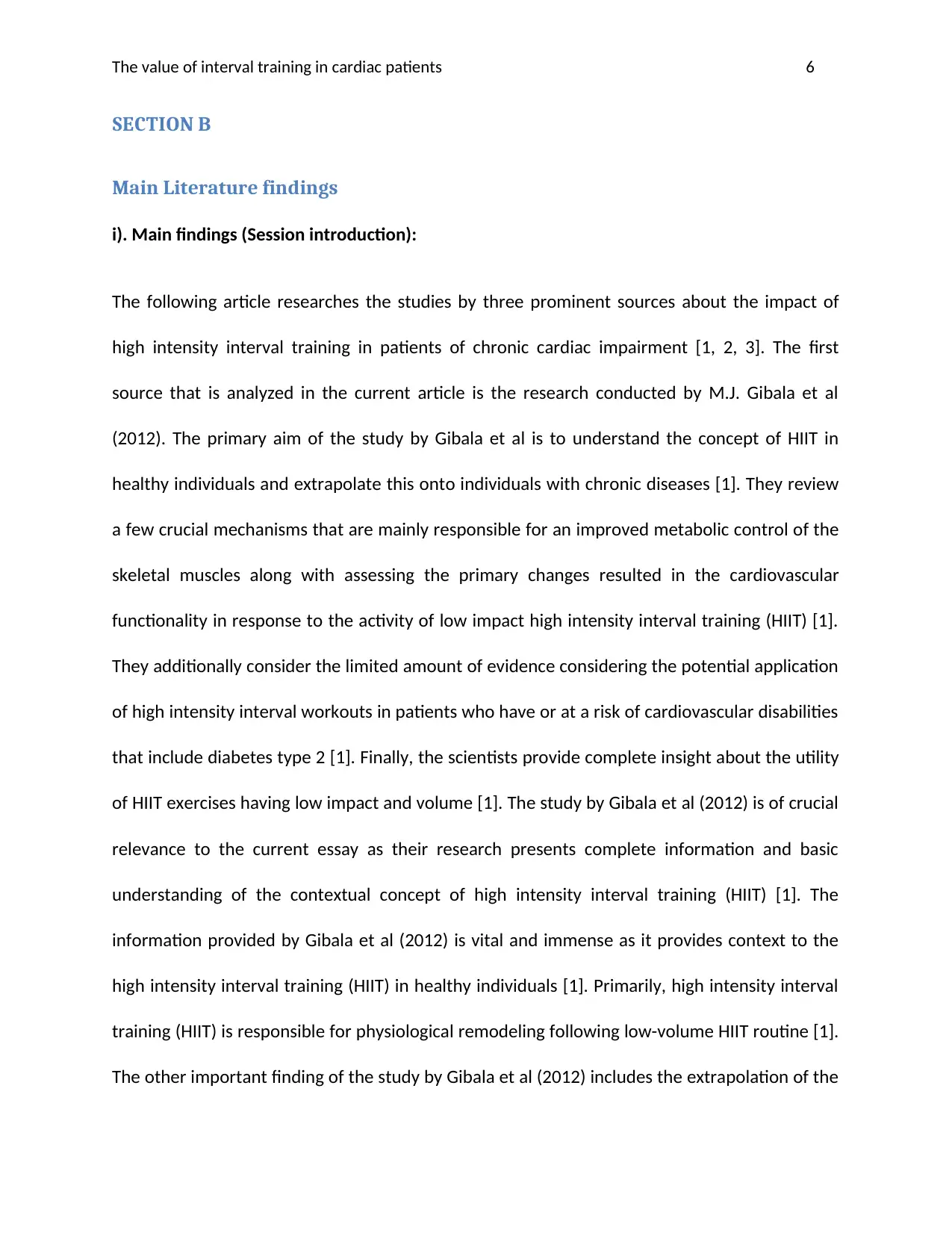
The value of interval training in cardiac patients 6
SECTION B
Main Literature findings
i). Main findings (Session introduction):
The following article researches the studies by three prominent sources about the impact of
high intensity interval training in patients of chronic cardiac impairment [1, 2, 3]. The first
source that is analyzed in the current article is the research conducted by M.J. Gibala et al
(2012). The primary aim of the study by Gibala et al is to understand the concept of HIIT in
healthy individuals and extrapolate this onto individuals with chronic diseases [1]. They review
a few crucial mechanisms that are mainly responsible for an improved metabolic control of the
skeletal muscles along with assessing the primary changes resulted in the cardiovascular
functionality in response to the activity of low impact high intensity interval training (HIIT) [1].
They additionally consider the limited amount of evidence considering the potential application
of high intensity interval workouts in patients who have or at a risk of cardiovascular disabilities
that include diabetes type 2 [1]. Finally, the scientists provide complete insight about the utility
of HIIT exercises having low impact and volume [1]. The study by Gibala et al (2012) is of crucial
relevance to the current essay as their research presents complete information and basic
understanding of the contextual concept of high intensity interval training (HIIT) [1]. The
information provided by Gibala et al (2012) is vital and immense as it provides context to the
high intensity interval training (HIIT) in healthy individuals [1]. Primarily, high intensity interval
training (HIIT) is responsible for physiological remodeling following low-volume HIIT routine [1].
The other important finding of the study by Gibala et al (2012) includes the extrapolation of the
SECTION B
Main Literature findings
i). Main findings (Session introduction):
The following article researches the studies by three prominent sources about the impact of
high intensity interval training in patients of chronic cardiac impairment [1, 2, 3]. The first
source that is analyzed in the current article is the research conducted by M.J. Gibala et al
(2012). The primary aim of the study by Gibala et al is to understand the concept of HIIT in
healthy individuals and extrapolate this onto individuals with chronic diseases [1]. They review
a few crucial mechanisms that are mainly responsible for an improved metabolic control of the
skeletal muscles along with assessing the primary changes resulted in the cardiovascular
functionality in response to the activity of low impact high intensity interval training (HIIT) [1].
They additionally consider the limited amount of evidence considering the potential application
of high intensity interval workouts in patients who have or at a risk of cardiovascular disabilities
that include diabetes type 2 [1]. Finally, the scientists provide complete insight about the utility
of HIIT exercises having low impact and volume [1]. The study by Gibala et al (2012) is of crucial
relevance to the current essay as their research presents complete information and basic
understanding of the contextual concept of high intensity interval training (HIIT) [1]. The
information provided by Gibala et al (2012) is vital and immense as it provides context to the
high intensity interval training (HIIT) in healthy individuals [1]. Primarily, high intensity interval
training (HIIT) is responsible for physiological remodeling following low-volume HIIT routine [1].
The other important finding of the study by Gibala et al (2012) includes the extrapolation of the
You're viewing a preview
Unlock full access by subscribing today!
Enjoy unlimited downloads | Full document access |
Advanced AI study tools
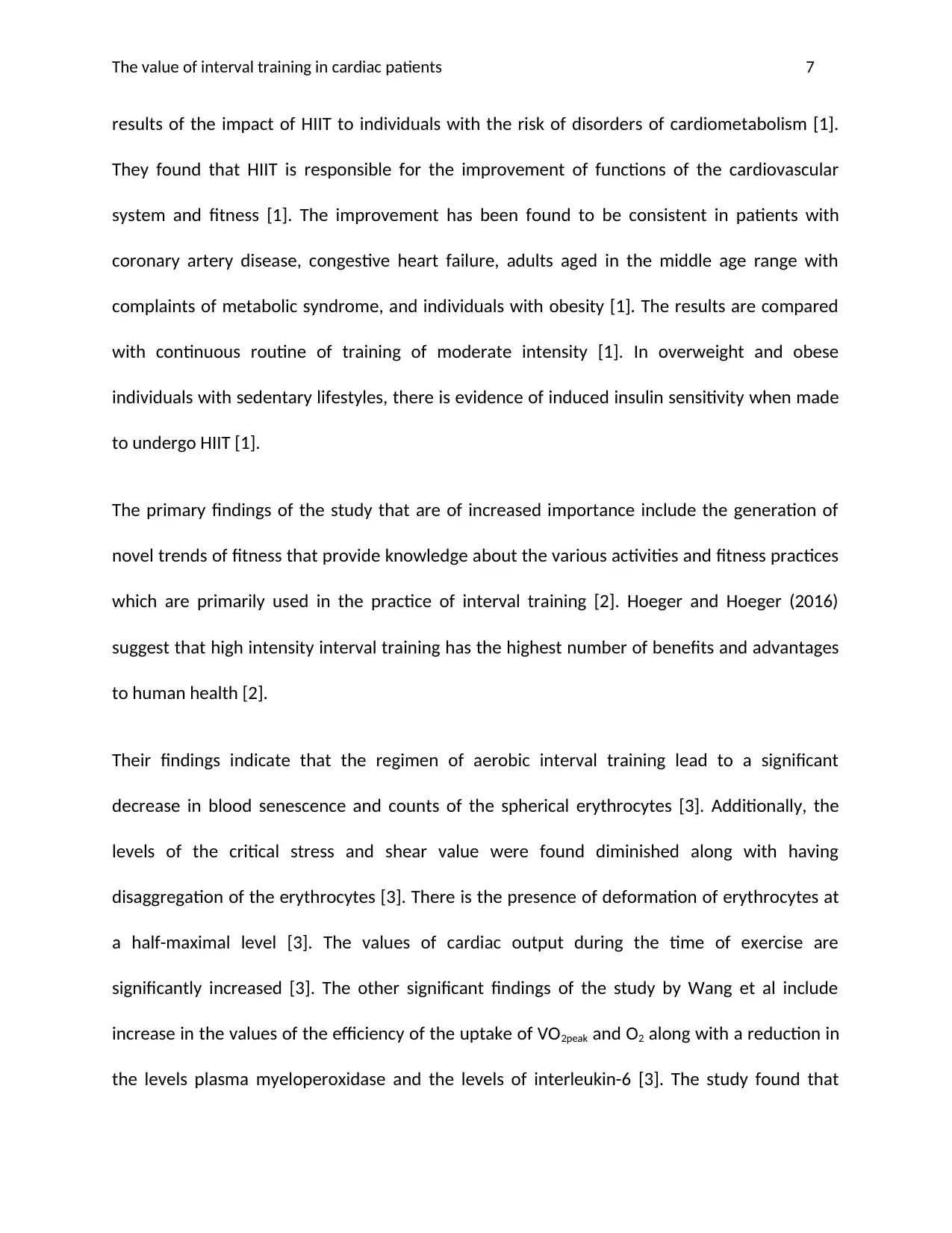
The value of interval training in cardiac patients 7
results of the impact of HIIT to individuals with the risk of disorders of cardiometabolism [1].
They found that HIIT is responsible for the improvement of functions of the cardiovascular
system and fitness [1]. The improvement has been found to be consistent in patients with
coronary artery disease, congestive heart failure, adults aged in the middle age range with
complaints of metabolic syndrome, and individuals with obesity [1]. The results are compared
with continuous routine of training of moderate intensity [1]. In overweight and obese
individuals with sedentary lifestyles, there is evidence of induced insulin sensitivity when made
to undergo HIIT [1].
The primary findings of the study that are of increased importance include the generation of
novel trends of fitness that provide knowledge about the various activities and fitness practices
which are primarily used in the practice of interval training [2]. Hoeger and Hoeger (2016)
suggest that high intensity interval training has the highest number of benefits and advantages
to human health [2].
Their findings indicate that the regimen of aerobic interval training lead to a significant
decrease in blood senescence and counts of the spherical erythrocytes [3]. Additionally, the
levels of the critical stress and shear value were found diminished along with having
disaggregation of the erythrocytes [3]. There is the presence of deformation of erythrocytes at
a half-maximal level [3]. The values of cardiac output during the time of exercise are
significantly increased [3]. The other significant findings of the study by Wang et al include
increase in the values of the efficiency of the uptake of VO2peak and O2 along with a reduction in
the levels plasma myeloperoxidase and the levels of interleukin-6 [3]. The study found that
results of the impact of HIIT to individuals with the risk of disorders of cardiometabolism [1].
They found that HIIT is responsible for the improvement of functions of the cardiovascular
system and fitness [1]. The improvement has been found to be consistent in patients with
coronary artery disease, congestive heart failure, adults aged in the middle age range with
complaints of metabolic syndrome, and individuals with obesity [1]. The results are compared
with continuous routine of training of moderate intensity [1]. In overweight and obese
individuals with sedentary lifestyles, there is evidence of induced insulin sensitivity when made
to undergo HIIT [1].
The primary findings of the study that are of increased importance include the generation of
novel trends of fitness that provide knowledge about the various activities and fitness practices
which are primarily used in the practice of interval training [2]. Hoeger and Hoeger (2016)
suggest that high intensity interval training has the highest number of benefits and advantages
to human health [2].
Their findings indicate that the regimen of aerobic interval training lead to a significant
decrease in blood senescence and counts of the spherical erythrocytes [3]. Additionally, the
levels of the critical stress and shear value were found diminished along with having
disaggregation of the erythrocytes [3]. There is the presence of deformation of erythrocytes at
a half-maximal level [3]. The values of cardiac output during the time of exercise are
significantly increased [3]. The other significant findings of the study by Wang et al include
increase in the values of the efficiency of the uptake of VO2peak and O2 along with a reduction in
the levels plasma myeloperoxidase and the levels of interleukin-6 [3]. The study found that
Paraphrase This Document
Need a fresh take? Get an instant paraphrase of this document with our AI Paraphraser
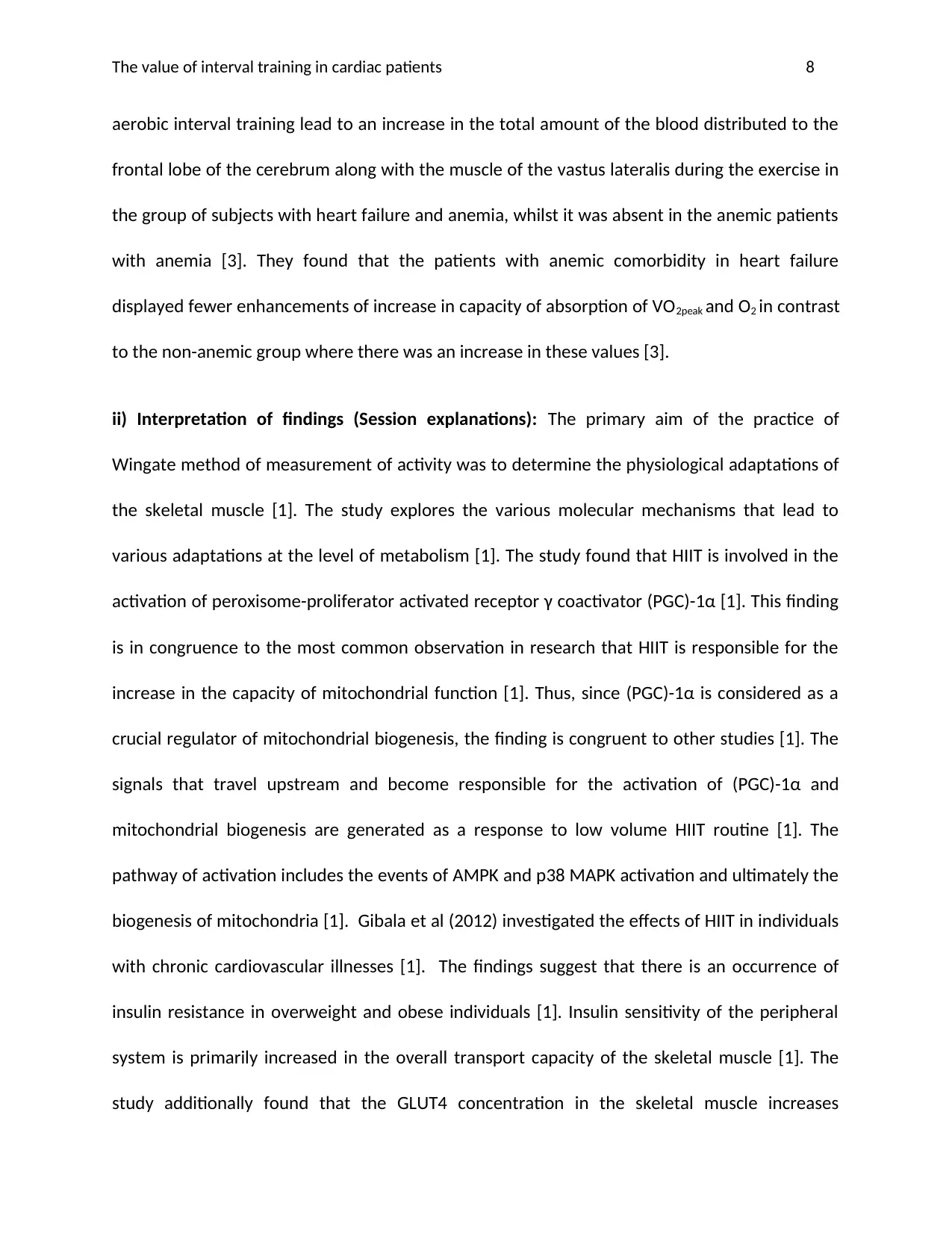
The value of interval training in cardiac patients 8
aerobic interval training lead to an increase in the total amount of the blood distributed to the
frontal lobe of the cerebrum along with the muscle of the vastus lateralis during the exercise in
the group of subjects with heart failure and anemia, whilst it was absent in the anemic patients
with anemia [3]. They found that the patients with anemic comorbidity in heart failure
displayed fewer enhancements of increase in capacity of absorption of VO2peak and O2 in contrast
to the non-anemic group where there was an increase in these values [3].
ii) Interpretation of findings (Session explanations): The primary aim of the practice of
Wingate method of measurement of activity was to determine the physiological adaptations of
the skeletal muscle [1]. The study explores the various molecular mechanisms that lead to
various adaptations at the level of metabolism [1]. The study found that HIIT is involved in the
activation of peroxisome-proliferator activated receptor γ coactivator (PGC)-1α [1]. This finding
is in congruence to the most common observation in research that HIIT is responsible for the
increase in the capacity of mitochondrial function [1]. Thus, since (PGC)-1α is considered as a
crucial regulator of mitochondrial biogenesis, the finding is congruent to other studies [1]. The
signals that travel upstream and become responsible for the activation of (PGC)-1α and
mitochondrial biogenesis are generated as a response to low volume HIIT routine [1]. The
pathway of activation includes the events of AMPK and p38 MAPK activation and ultimately the
biogenesis of mitochondria [1]. Gibala et al (2012) investigated the effects of HIIT in individuals
with chronic cardiovascular illnesses [1]. The findings suggest that there is an occurrence of
insulin resistance in overweight and obese individuals [1]. Insulin sensitivity of the peripheral
system is primarily increased in the overall transport capacity of the skeletal muscle [1]. The
study additionally found that the GLUT4 concentration in the skeletal muscle increases
aerobic interval training lead to an increase in the total amount of the blood distributed to the
frontal lobe of the cerebrum along with the muscle of the vastus lateralis during the exercise in
the group of subjects with heart failure and anemia, whilst it was absent in the anemic patients
with anemia [3]. They found that the patients with anemic comorbidity in heart failure
displayed fewer enhancements of increase in capacity of absorption of VO2peak and O2 in contrast
to the non-anemic group where there was an increase in these values [3].
ii) Interpretation of findings (Session explanations): The primary aim of the practice of
Wingate method of measurement of activity was to determine the physiological adaptations of
the skeletal muscle [1]. The study explores the various molecular mechanisms that lead to
various adaptations at the level of metabolism [1]. The study found that HIIT is involved in the
activation of peroxisome-proliferator activated receptor γ coactivator (PGC)-1α [1]. This finding
is in congruence to the most common observation in research that HIIT is responsible for the
increase in the capacity of mitochondrial function [1]. Thus, since (PGC)-1α is considered as a
crucial regulator of mitochondrial biogenesis, the finding is congruent to other studies [1]. The
signals that travel upstream and become responsible for the activation of (PGC)-1α and
mitochondrial biogenesis are generated as a response to low volume HIIT routine [1]. The
pathway of activation includes the events of AMPK and p38 MAPK activation and ultimately the
biogenesis of mitochondria [1]. Gibala et al (2012) investigated the effects of HIIT in individuals
with chronic cardiovascular illnesses [1]. The findings suggest that there is an occurrence of
insulin resistance in overweight and obese individuals [1]. Insulin sensitivity of the peripheral
system is primarily increased in the overall transport capacity of the skeletal muscle [1]. The
study additionally found that the GLUT4 concentration in the skeletal muscle increases
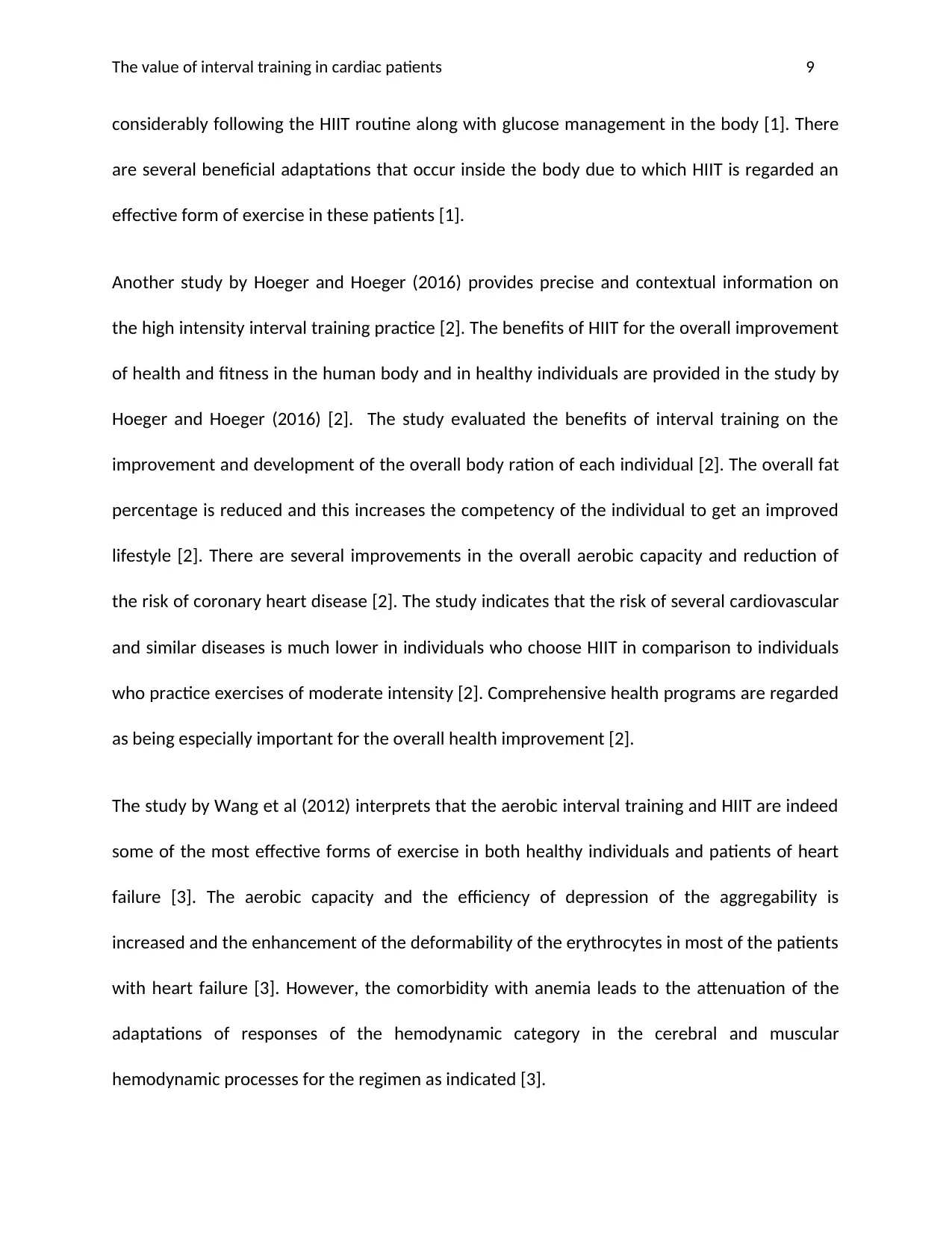
The value of interval training in cardiac patients 9
considerably following the HIIT routine along with glucose management in the body [1]. There
are several beneficial adaptations that occur inside the body due to which HIIT is regarded an
effective form of exercise in these patients [1].
Another study by Hoeger and Hoeger (2016) provides precise and contextual information on
the high intensity interval training practice [2]. The benefits of HIIT for the overall improvement
of health and fitness in the human body and in healthy individuals are provided in the study by
Hoeger and Hoeger (2016) [2]. The study evaluated the benefits of interval training on the
improvement and development of the overall body ration of each individual [2]. The overall fat
percentage is reduced and this increases the competency of the individual to get an improved
lifestyle [2]. There are several improvements in the overall aerobic capacity and reduction of
the risk of coronary heart disease [2]. The study indicates that the risk of several cardiovascular
and similar diseases is much lower in individuals who choose HIIT in comparison to individuals
who practice exercises of moderate intensity [2]. Comprehensive health programs are regarded
as being especially important for the overall health improvement [2].
The study by Wang et al (2012) interprets that the aerobic interval training and HIIT are indeed
some of the most effective forms of exercise in both healthy individuals and patients of heart
failure [3]. The aerobic capacity and the efficiency of depression of the aggregability is
increased and the enhancement of the deformability of the erythrocytes in most of the patients
with heart failure [3]. However, the comorbidity with anemia leads to the attenuation of the
adaptations of responses of the hemodynamic category in the cerebral and muscular
hemodynamic processes for the regimen as indicated [3].
considerably following the HIIT routine along with glucose management in the body [1]. There
are several beneficial adaptations that occur inside the body due to which HIIT is regarded an
effective form of exercise in these patients [1].
Another study by Hoeger and Hoeger (2016) provides precise and contextual information on
the high intensity interval training practice [2]. The benefits of HIIT for the overall improvement
of health and fitness in the human body and in healthy individuals are provided in the study by
Hoeger and Hoeger (2016) [2]. The study evaluated the benefits of interval training on the
improvement and development of the overall body ration of each individual [2]. The overall fat
percentage is reduced and this increases the competency of the individual to get an improved
lifestyle [2]. There are several improvements in the overall aerobic capacity and reduction of
the risk of coronary heart disease [2]. The study indicates that the risk of several cardiovascular
and similar diseases is much lower in individuals who choose HIIT in comparison to individuals
who practice exercises of moderate intensity [2]. Comprehensive health programs are regarded
as being especially important for the overall health improvement [2].
The study by Wang et al (2012) interprets that the aerobic interval training and HIIT are indeed
some of the most effective forms of exercise in both healthy individuals and patients of heart
failure [3]. The aerobic capacity and the efficiency of depression of the aggregability is
increased and the enhancement of the deformability of the erythrocytes in most of the patients
with heart failure [3]. However, the comorbidity with anemia leads to the attenuation of the
adaptations of responses of the hemodynamic category in the cerebral and muscular
hemodynamic processes for the regimen as indicated [3].
You're viewing a preview
Unlock full access by subscribing today!
Enjoy unlimited downloads | Full document access |
Advanced AI study tools
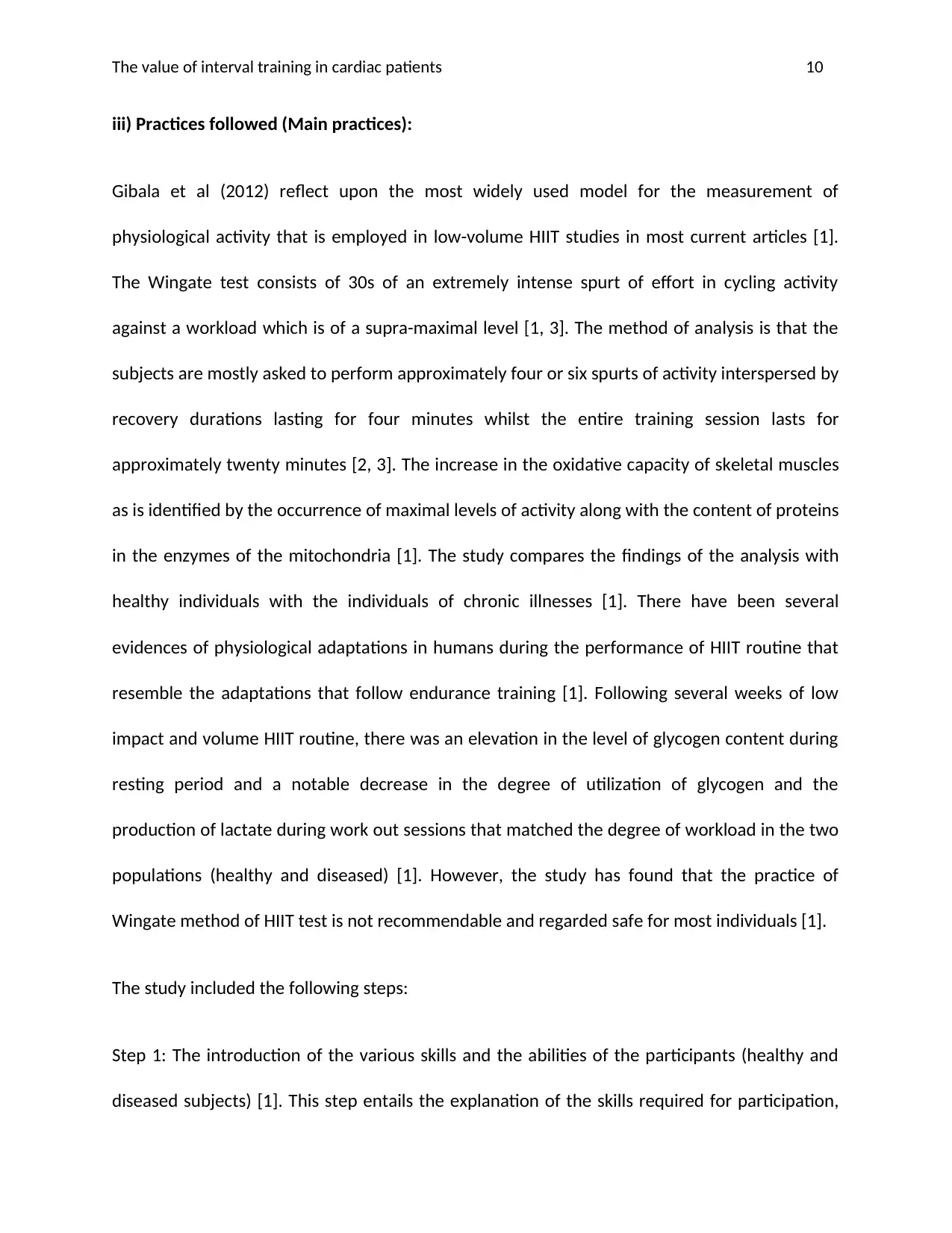
The value of interval training in cardiac patients 10
iii) Practices followed (Main practices):
Gibala et al (2012) reflect upon the most widely used model for the measurement of
physiological activity that is employed in low-volume HIIT studies in most current articles [1].
The Wingate test consists of 30s of an extremely intense spurt of effort in cycling activity
against a workload which is of a supra-maximal level [1, 3]. The method of analysis is that the
subjects are mostly asked to perform approximately four or six spurts of activity interspersed by
recovery durations lasting for four minutes whilst the entire training session lasts for
approximately twenty minutes [2, 3]. The increase in the oxidative capacity of skeletal muscles
as is identified by the occurrence of maximal levels of activity along with the content of proteins
in the enzymes of the mitochondria [1]. The study compares the findings of the analysis with
healthy individuals with the individuals of chronic illnesses [1]. There have been several
evidences of physiological adaptations in humans during the performance of HIIT routine that
resemble the adaptations that follow endurance training [1]. Following several weeks of low
impact and volume HIIT routine, there was an elevation in the level of glycogen content during
resting period and a notable decrease in the degree of utilization of glycogen and the
production of lactate during work out sessions that matched the degree of workload in the two
populations (healthy and diseased) [1]. However, the study has found that the practice of
Wingate method of HIIT test is not recommendable and regarded safe for most individuals [1].
The study included the following steps:
Step 1: The introduction of the various skills and the abilities of the participants (healthy and
diseased subjects) [1]. This step entails the explanation of the skills required for participation,
iii) Practices followed (Main practices):
Gibala et al (2012) reflect upon the most widely used model for the measurement of
physiological activity that is employed in low-volume HIIT studies in most current articles [1].
The Wingate test consists of 30s of an extremely intense spurt of effort in cycling activity
against a workload which is of a supra-maximal level [1, 3]. The method of analysis is that the
subjects are mostly asked to perform approximately four or six spurts of activity interspersed by
recovery durations lasting for four minutes whilst the entire training session lasts for
approximately twenty minutes [2, 3]. The increase in the oxidative capacity of skeletal muscles
as is identified by the occurrence of maximal levels of activity along with the content of proteins
in the enzymes of the mitochondria [1]. The study compares the findings of the analysis with
healthy individuals with the individuals of chronic illnesses [1]. There have been several
evidences of physiological adaptations in humans during the performance of HIIT routine that
resemble the adaptations that follow endurance training [1]. Following several weeks of low
impact and volume HIIT routine, there was an elevation in the level of glycogen content during
resting period and a notable decrease in the degree of utilization of glycogen and the
production of lactate during work out sessions that matched the degree of workload in the two
populations (healthy and diseased) [1]. However, the study has found that the practice of
Wingate method of HIIT test is not recommendable and regarded safe for most individuals [1].
The study included the following steps:
Step 1: The introduction of the various skills and the abilities of the participants (healthy and
diseased subjects) [1]. This step entails the explanation of the skills required for participation,
Paraphrase This Document
Need a fresh take? Get an instant paraphrase of this document with our AI Paraphraser
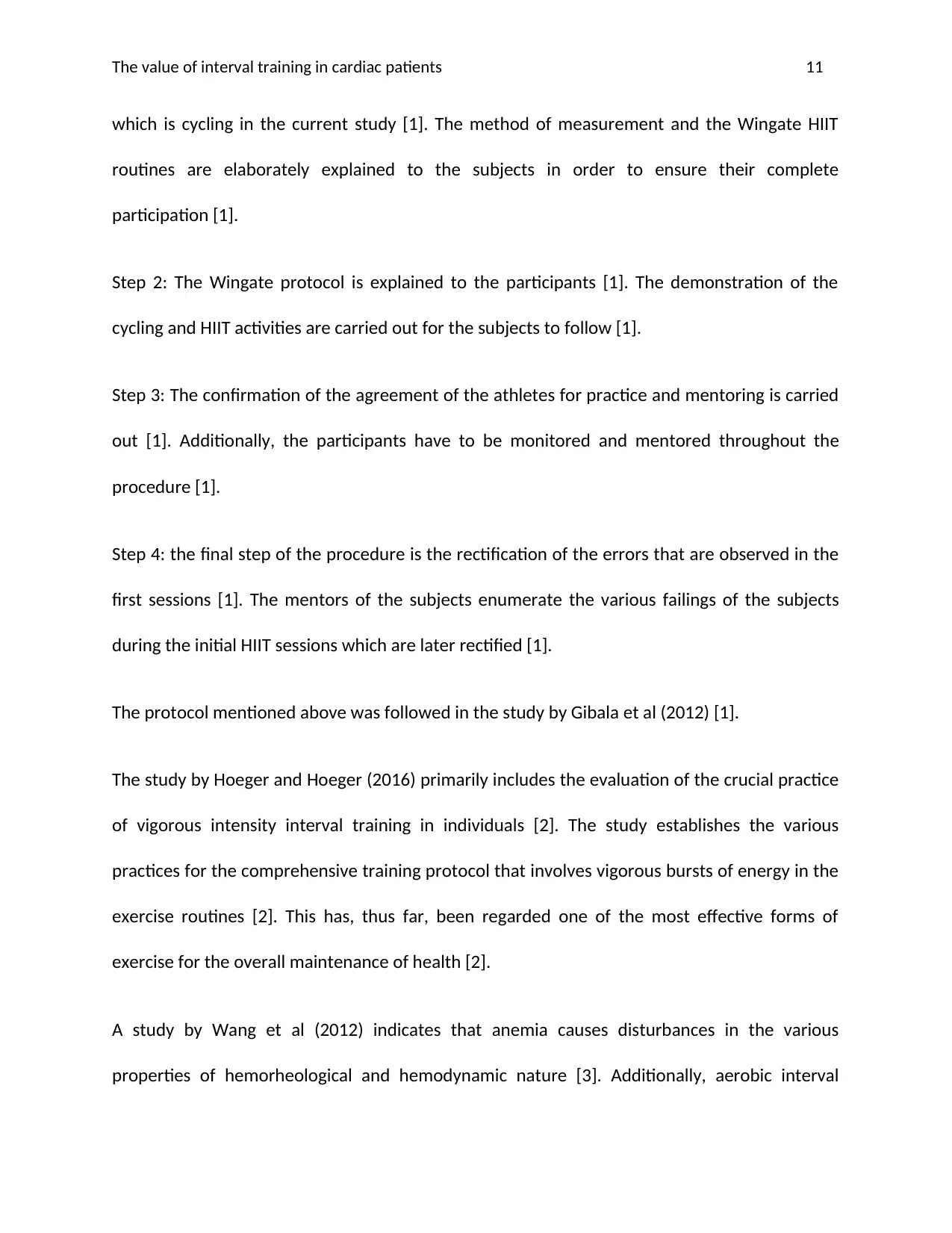
The value of interval training in cardiac patients 11
which is cycling in the current study [1]. The method of measurement and the Wingate HIIT
routines are elaborately explained to the subjects in order to ensure their complete
participation [1].
Step 2: The Wingate protocol is explained to the participants [1]. The demonstration of the
cycling and HIIT activities are carried out for the subjects to follow [1].
Step 3: The confirmation of the agreement of the athletes for practice and mentoring is carried
out [1]. Additionally, the participants have to be monitored and mentored throughout the
procedure [1].
Step 4: the final step of the procedure is the rectification of the errors that are observed in the
first sessions [1]. The mentors of the subjects enumerate the various failings of the subjects
during the initial HIIT sessions which are later rectified [1].
The protocol mentioned above was followed in the study by Gibala et al (2012) [1].
The study by Hoeger and Hoeger (2016) primarily includes the evaluation of the crucial practice
of vigorous intensity interval training in individuals [2]. The study establishes the various
practices for the comprehensive training protocol that involves vigorous bursts of energy in the
exercise routines [2]. This has, thus far, been regarded one of the most effective forms of
exercise for the overall maintenance of health [2].
A study by Wang et al (2012) indicates that anemia causes disturbances in the various
properties of hemorheological and hemodynamic nature [3]. Additionally, aerobic interval
which is cycling in the current study [1]. The method of measurement and the Wingate HIIT
routines are elaborately explained to the subjects in order to ensure their complete
participation [1].
Step 2: The Wingate protocol is explained to the participants [1]. The demonstration of the
cycling and HIIT activities are carried out for the subjects to follow [1].
Step 3: The confirmation of the agreement of the athletes for practice and mentoring is carried
out [1]. Additionally, the participants have to be monitored and mentored throughout the
procedure [1].
Step 4: the final step of the procedure is the rectification of the errors that are observed in the
first sessions [1]. The mentors of the subjects enumerate the various failings of the subjects
during the initial HIIT sessions which are later rectified [1].
The protocol mentioned above was followed in the study by Gibala et al (2012) [1].
The study by Hoeger and Hoeger (2016) primarily includes the evaluation of the crucial practice
of vigorous intensity interval training in individuals [2]. The study establishes the various
practices for the comprehensive training protocol that involves vigorous bursts of energy in the
exercise routines [2]. This has, thus far, been regarded one of the most effective forms of
exercise for the overall maintenance of health [2].
A study by Wang et al (2012) indicates that anemia causes disturbances in the various
properties of hemorheological and hemodynamic nature [3]. Additionally, aerobic interval
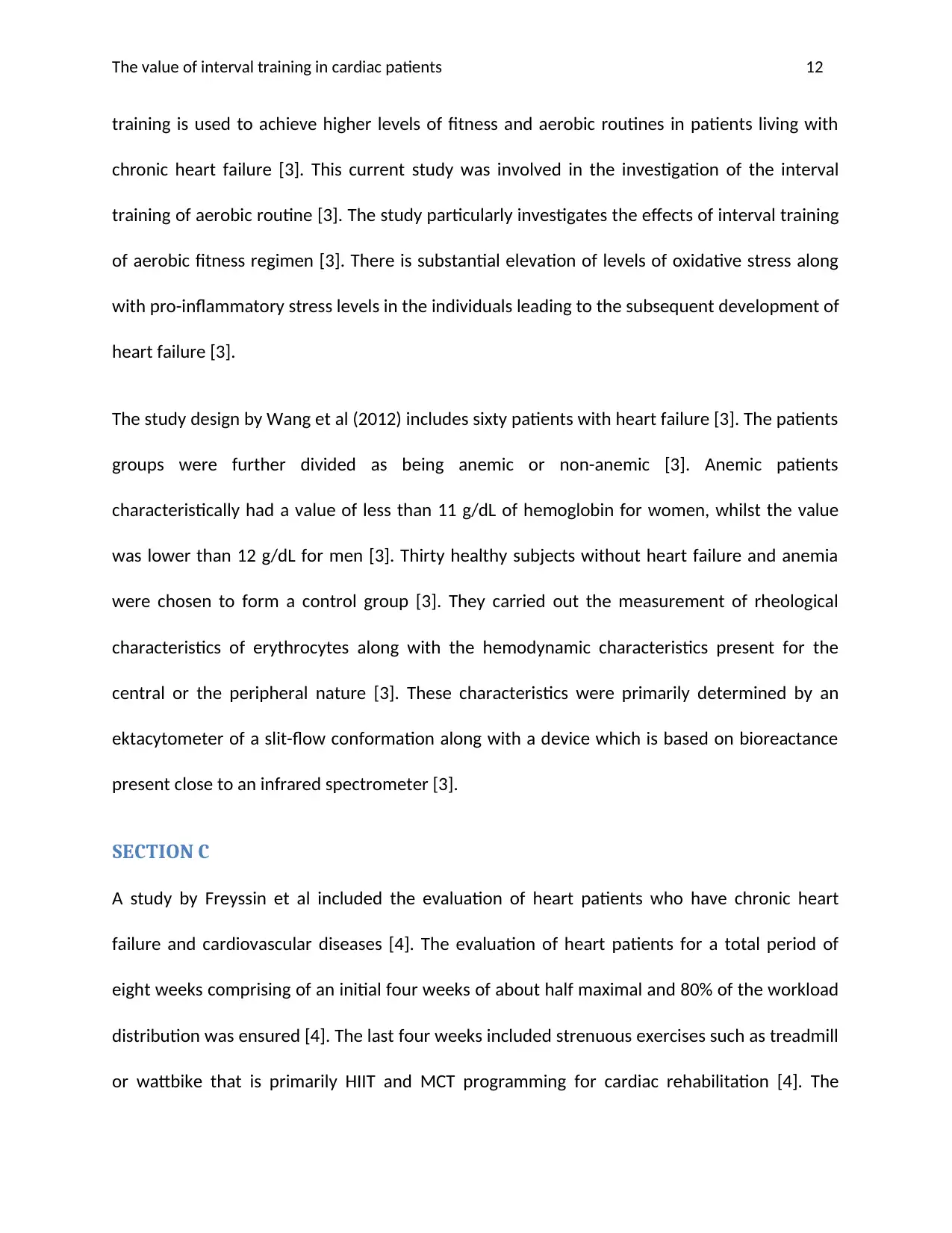
The value of interval training in cardiac patients 12
training is used to achieve higher levels of fitness and aerobic routines in patients living with
chronic heart failure [3]. This current study was involved in the investigation of the interval
training of aerobic routine [3]. The study particularly investigates the effects of interval training
of aerobic fitness regimen [3]. There is substantial elevation of levels of oxidative stress along
with pro-inflammatory stress levels in the individuals leading to the subsequent development of
heart failure [3].
The study design by Wang et al (2012) includes sixty patients with heart failure [3]. The patients
groups were further divided as being anemic or non-anemic [3]. Anemic patients
characteristically had a value of less than 11 g/dL of hemoglobin for women, whilst the value
was lower than 12 g/dL for men [3]. Thirty healthy subjects without heart failure and anemia
were chosen to form a control group [3]. They carried out the measurement of rheological
characteristics of erythrocytes along with the hemodynamic characteristics present for the
central or the peripheral nature [3]. These characteristics were primarily determined by an
ektacytometer of a slit-flow conformation along with a device which is based on bioreactance
present close to an infrared spectrometer [3].
SECTION C
A study by Freyssin et al included the evaluation of heart patients who have chronic heart
failure and cardiovascular diseases [4]. The evaluation of heart patients for a total period of
eight weeks comprising of an initial four weeks of about half maximal and 80% of the workload
distribution was ensured [4]. The last four weeks included strenuous exercises such as treadmill
or wattbike that is primarily HIIT and MCT programming for cardiac rehabilitation [4]. The
training is used to achieve higher levels of fitness and aerobic routines in patients living with
chronic heart failure [3]. This current study was involved in the investigation of the interval
training of aerobic routine [3]. The study particularly investigates the effects of interval training
of aerobic fitness regimen [3]. There is substantial elevation of levels of oxidative stress along
with pro-inflammatory stress levels in the individuals leading to the subsequent development of
heart failure [3].
The study design by Wang et al (2012) includes sixty patients with heart failure [3]. The patients
groups were further divided as being anemic or non-anemic [3]. Anemic patients
characteristically had a value of less than 11 g/dL of hemoglobin for women, whilst the value
was lower than 12 g/dL for men [3]. Thirty healthy subjects without heart failure and anemia
were chosen to form a control group [3]. They carried out the measurement of rheological
characteristics of erythrocytes along with the hemodynamic characteristics present for the
central or the peripheral nature [3]. These characteristics were primarily determined by an
ektacytometer of a slit-flow conformation along with a device which is based on bioreactance
present close to an infrared spectrometer [3].
SECTION C
A study by Freyssin et al included the evaluation of heart patients who have chronic heart
failure and cardiovascular diseases [4]. The evaluation of heart patients for a total period of
eight weeks comprising of an initial four weeks of about half maximal and 80% of the workload
distribution was ensured [4]. The last four weeks included strenuous exercises such as treadmill
or wattbike that is primarily HIIT and MCT programming for cardiac rehabilitation [4]. The
You're viewing a preview
Unlock full access by subscribing today!
Enjoy unlimited downloads | Full document access |
Advanced AI study tools
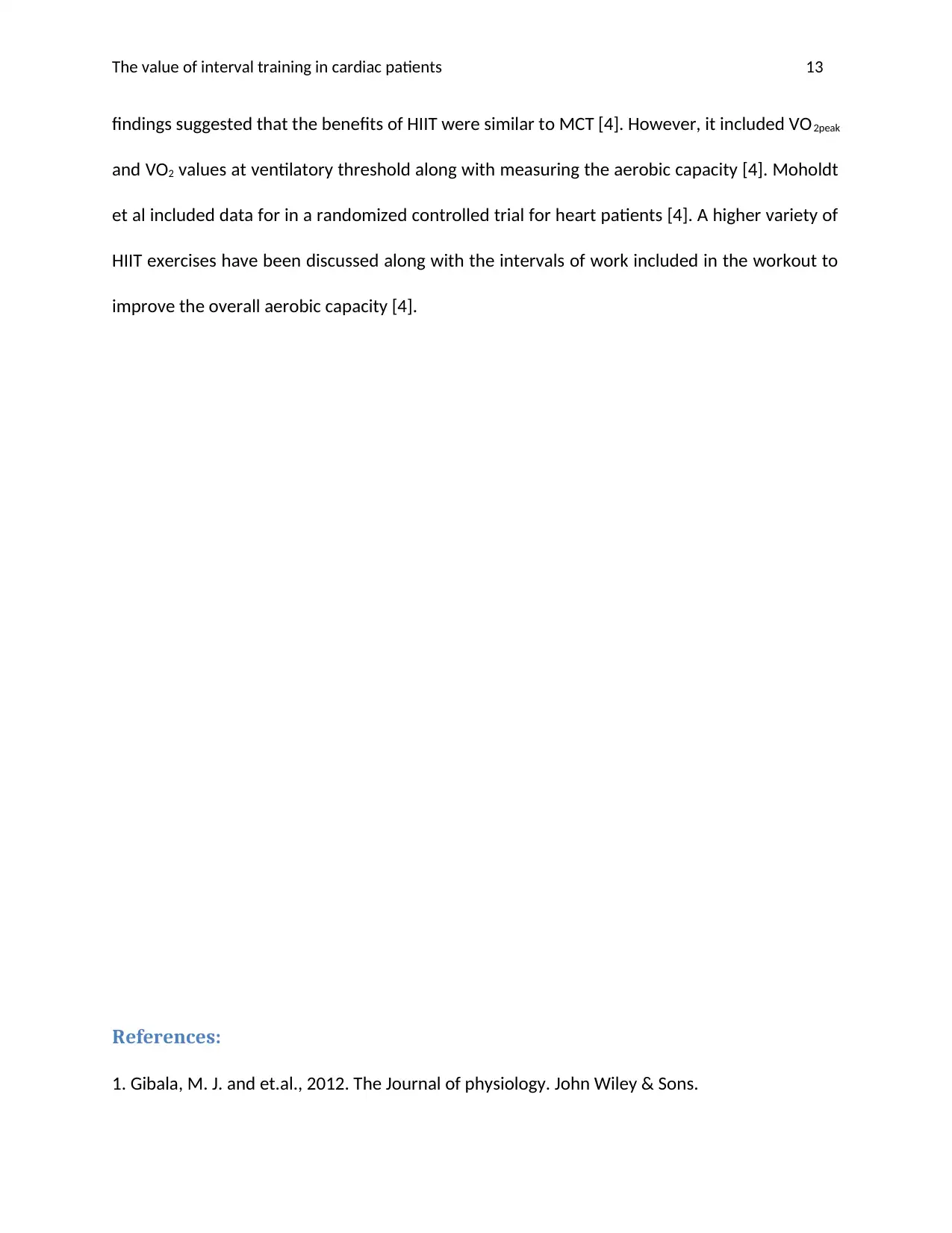
The value of interval training in cardiac patients 13
findings suggested that the benefits of HIIT were similar to MCT [4]. However, it included VO2peak
and VO2 values at ventilatory threshold along with measuring the aerobic capacity [4]. Moholdt
et al included data for in a randomized controlled trial for heart patients [4]. A higher variety of
HIIT exercises have been discussed along with the intervals of work included in the workout to
improve the overall aerobic capacity [4].
References:
1. Gibala, M. J. and et.al., 2012. The Journal of physiology. John Wiley & Sons.
findings suggested that the benefits of HIIT were similar to MCT [4]. However, it included VO2peak
and VO2 values at ventilatory threshold along with measuring the aerobic capacity [4]. Moholdt
et al included data for in a randomized controlled trial for heart patients [4]. A higher variety of
HIIT exercises have been discussed along with the intervals of work included in the workout to
improve the overall aerobic capacity [4].
References:
1. Gibala, M. J. and et.al., 2012. The Journal of physiology. John Wiley & Sons.
Paraphrase This Document
Need a fresh take? Get an instant paraphrase of this document with our AI Paraphraser
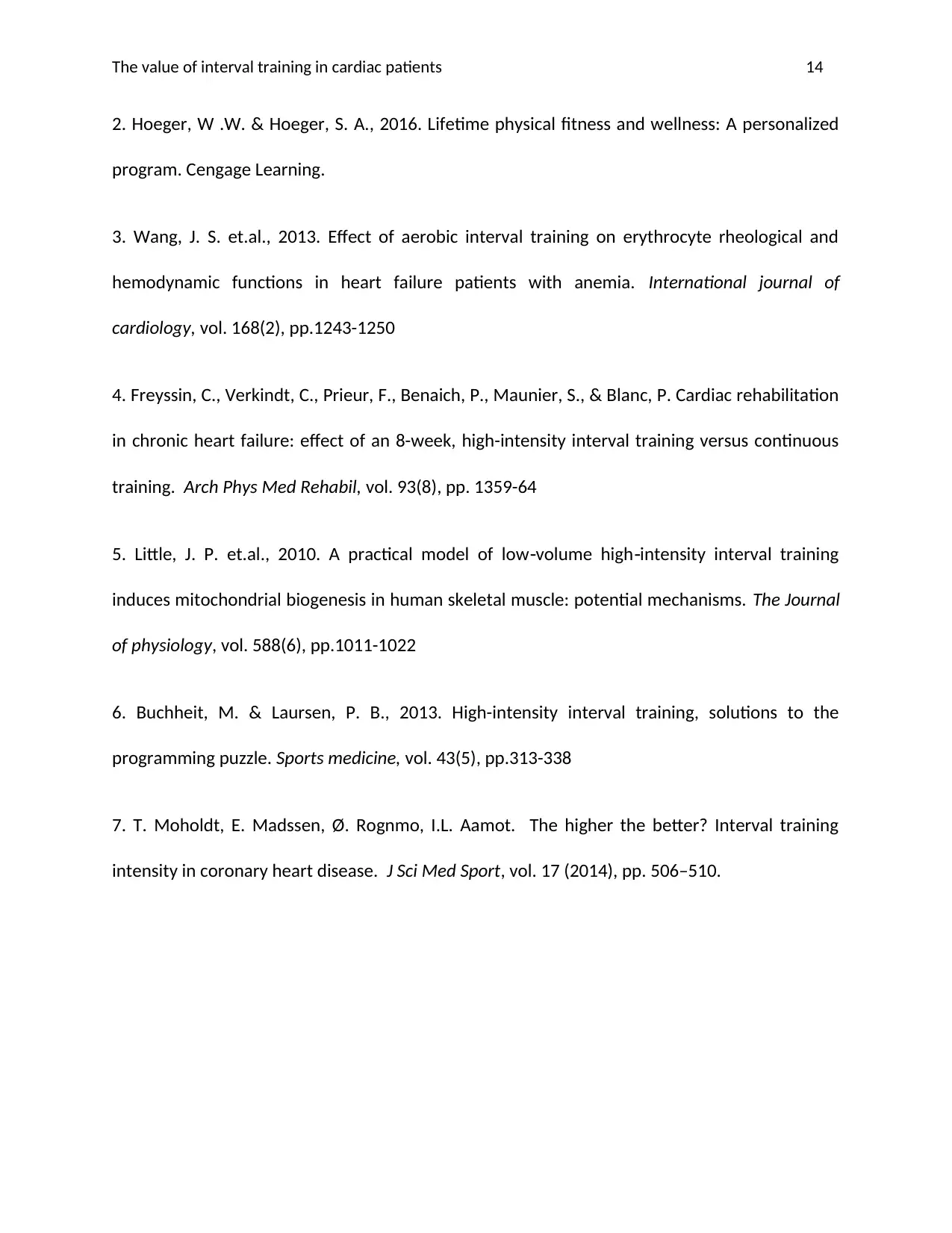
The value of interval training in cardiac patients 14
2. Hoeger, W .W. & Hoeger, S. A., 2016. Lifetime physical fitness and wellness: A personalized
program. Cengage Learning.
3. Wang, J. S. et.al., 2013. Effect of aerobic interval training on erythrocyte rheological and
hemodynamic functions in heart failure patients with anemia. International journal of
cardiology, vol. 168(2), pp.1243-1250
4. Freyssin, C., Verkindt, C., Prieur, F., Benaich, P., Maunier, S., & Blanc, P. Cardiac rehabilitation
in chronic heart failure: effect of an 8-week, high-intensity interval training versus continuous
training. Arch Phys Med Rehabil, vol. 93(8), pp. 1359-64
5. Little, J. P. et.al., 2010. A practical model of low volume high intensity interval training‐ ‐
induces mitochondrial biogenesis in human skeletal muscle: potential mechanisms. The Journal
of physiology, vol. 588(6), pp.1011-1022
6. Buchheit, M. & Laursen, P. B., 2013. High-intensity interval training, solutions to the
programming puzzle. Sports medicine, vol. 43(5), pp.313-338
7. T. Moholdt, E. Madssen, Ø. Rognmo, I.L. Aamot. The higher the better? Interval training
intensity in coronary heart disease. J Sci Med Sport, vol. 17 (2014), pp. 506–510.
2. Hoeger, W .W. & Hoeger, S. A., 2016. Lifetime physical fitness and wellness: A personalized
program. Cengage Learning.
3. Wang, J. S. et.al., 2013. Effect of aerobic interval training on erythrocyte rheological and
hemodynamic functions in heart failure patients with anemia. International journal of
cardiology, vol. 168(2), pp.1243-1250
4. Freyssin, C., Verkindt, C., Prieur, F., Benaich, P., Maunier, S., & Blanc, P. Cardiac rehabilitation
in chronic heart failure: effect of an 8-week, high-intensity interval training versus continuous
training. Arch Phys Med Rehabil, vol. 93(8), pp. 1359-64
5. Little, J. P. et.al., 2010. A practical model of low volume high intensity interval training‐ ‐
induces mitochondrial biogenesis in human skeletal muscle: potential mechanisms. The Journal
of physiology, vol. 588(6), pp.1011-1022
6. Buchheit, M. & Laursen, P. B., 2013. High-intensity interval training, solutions to the
programming puzzle. Sports medicine, vol. 43(5), pp.313-338
7. T. Moholdt, E. Madssen, Ø. Rognmo, I.L. Aamot. The higher the better? Interval training
intensity in coronary heart disease. J Sci Med Sport, vol. 17 (2014), pp. 506–510.
1 out of 14
Related Documents
Your All-in-One AI-Powered Toolkit for Academic Success.
+13062052269
info@desklib.com
Available 24*7 on WhatsApp / Email
![[object Object]](/_next/static/media/star-bottom.7253800d.svg)
Unlock your academic potential
© 2024 | Zucol Services PVT LTD | All rights reserved.





